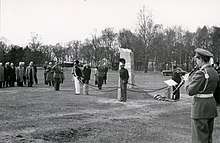Halland Battalion
Halland Battalion (Swedish: Hallands bataljon), designated № 28, was an infantry unit of the Swedish Army that was active in various forms from 1813 to 1901. The unit was based in Halmstad Garrison in Halmstad.[2][3]
| Halland Battalion | |
|---|---|
| Hallands bataljon | |
| Active | 1813–1901 |
| Country | Sweden |
| Allegiance | Swedish Armed Forces |
| Branch | Swedish Army |
| Type | Infantry |
| Size | Battalion |
| Part of | Älvsborg Regiment (1816–1835) 3rd Military District (1835–1893) 3rd Army Division (1893–1901) |
| Garrison/HQ | Halmstad |
| Colors | Blue |
| March | "Hallands bataljons marsch" (Heimdahl)[note 1] |
| Insignia | |
| Colour |  |
History
Halland Battalion was raised on 14 May 1813, under the name of Hallands läns första infanteribataljon ("Halland County First Infantry Battalion"). From 1813 to 1835, the battalion was partly subordinated to Älvsborg Regiment. On 30 October 1818, the battalion adopted the name of Halland Infantry Battalion. In 1835, the battalion was separated from Älvsborg Regiment, and formed an independent unit. On 1 January 1887, the name Halland Battalion was adopted.[3] On 31 December 1901, the battalion was disbanded as an independent unit, and from 1 January 1902 it was amalgamated with Värmland Rifle Corps (Värmlands fältjägarkår) and formed Vaxholm Grenadier Regiment.[2]
Barracks and training areas
When the battalion was raised in 1813, it was placed to Öster mosse (literally "Eastern bog") outside Halmstad. In 1816, the battalion was placed on the Påskberget ("Easter Mountain") in Varberg. On 22 June 1833, the battalion was placed to Galgberget in Halmstad, and on 15 April 1844 it was relocated back to Öster mosse. Between 1857 and 1901, the battalion was located in Skedalahed, about 5 km east of Halmstad. However, the regimental staff was located in Halmstad.[3]
Heraldry and traditions

On 24 April 1862, the battalion was presented with a colour at a ceremony at Skedalahed. After the battalion was disbanded, Vaxholm Grenadier Regiment came to carry the colour alongside the colour of the Värmland Rifle Corps.[2] In 1959, Halland Regiment erected a memorial stone over the battalion's time at Skedalahed. In connection with the Swedish Armed Forces leaving Skedalahed in 2000, the stone was moved to a new location.
Commanding officers
- 1813–1873: ?
- 1873–1881: Helmer Falk
- 1881–1901: ?
Names, designations and locations
| Name | Translation | From | To | |
|---|---|---|---|---|
| Kungl Hallands läns första infanteribataljon | Royal Halland County First Infantry Battalion | 1813-05-14 | – | 1818-10-29 |
| Kungl Hallands infanteribataljon | Royal Halland Infantry Battalion | 1818-10-30 | – | 1886-12-31 |
| Kungl Hallands bataljon | Royal Halland Battalion | 1887-01-01 | – | 1901-12-31 |
| Designation | From | To | ||
| № 28 | 1816-10-01 | – | 1901-12-31 | |
| Location | From | To | ||
| Halmstad/Öster Mosse | 1813-05-14 | – | 1816-??-?? | |
| Varberg/Påskberget | 1816-??-?? | – | 1833-06-21 | |
| Halmstad | 1833-06-22 | – | 1844-04-14 | |
| Halmstad | 1844-04-15 | – | 1857-??-?? | |
| Skedalahed | 1857-??-?? | – | 1901-12-31 |
Footnotes
- The march was adopted during the 1890s.[1]
References
Notes
- Sandberg 2007, p. 37
- Braunstein 2003, p. 109
- Holmberg 1993, p. 17
Print
- Braunstein, Christian (2003). Sveriges arméförband under 1900-talet. Skrift / Statens försvarshistoriska museer, 1101-7023 ; 5 (in Swedish). Stockholm: Statens försvarshistoriska museer. ISBN 91-971584-4-5. SELIBR 8902928.CS1 maint: ref=harv (link)
- Holmberg, Björn (1993). Arméns regementen, skolor och staber: [en uppslagsbok] : en sammanställning (in Swedish). Arvidsjaur: Svenskt militärhistoriskt bibliotek (SMB). ISBN 91-972209-0-6. SELIBR 7796532.CS1 maint: ref=harv (link)
- Sandberg, Bo (2007). Försvarets marscher och signaler förr och nu: marscher antagna av svenska militära förband, skolor och staber samt igenkännings-, tjänstgörings- och exercissignaler (in Swedish) (New ed.). Stockholm: Militärmusiksamfundet med Svenskt marscharkiv. ISBN 978-91-631-8699-8. SELIBR 10413065.CS1 maint: ref=harv (link)
Further reading
| Wikimedia Commons has media related to Halland Battalion. |
- Berggren, Gustaf (1955). Halländska truppförband och hembygden efter Roskildefreden (in Swedish). Halmstad. SELIBR 12159427.
- Cöster, Fredrik (1901). Hallands bataljons krigsminne: några anteckningar från kriget 1814 af en dåvarande beväringssoldat i bataljonen (in Swedish). Halmstad. SELIBR 3200818.
- Leijonhufvud, Erik (1907). N:r 28. Kungl. Hallands bataljon (in Swedish). Stockholm. SELIBR 2769010.